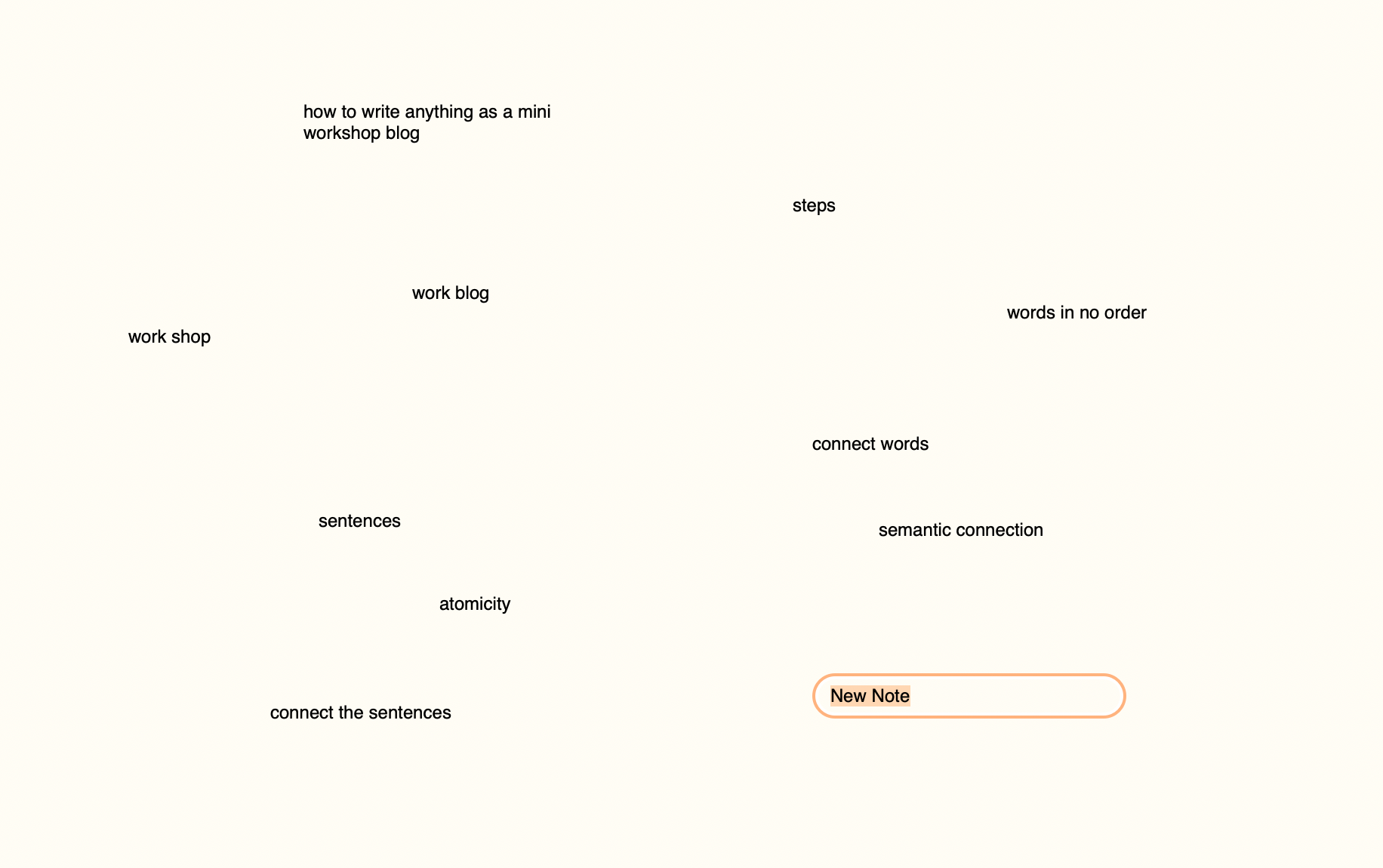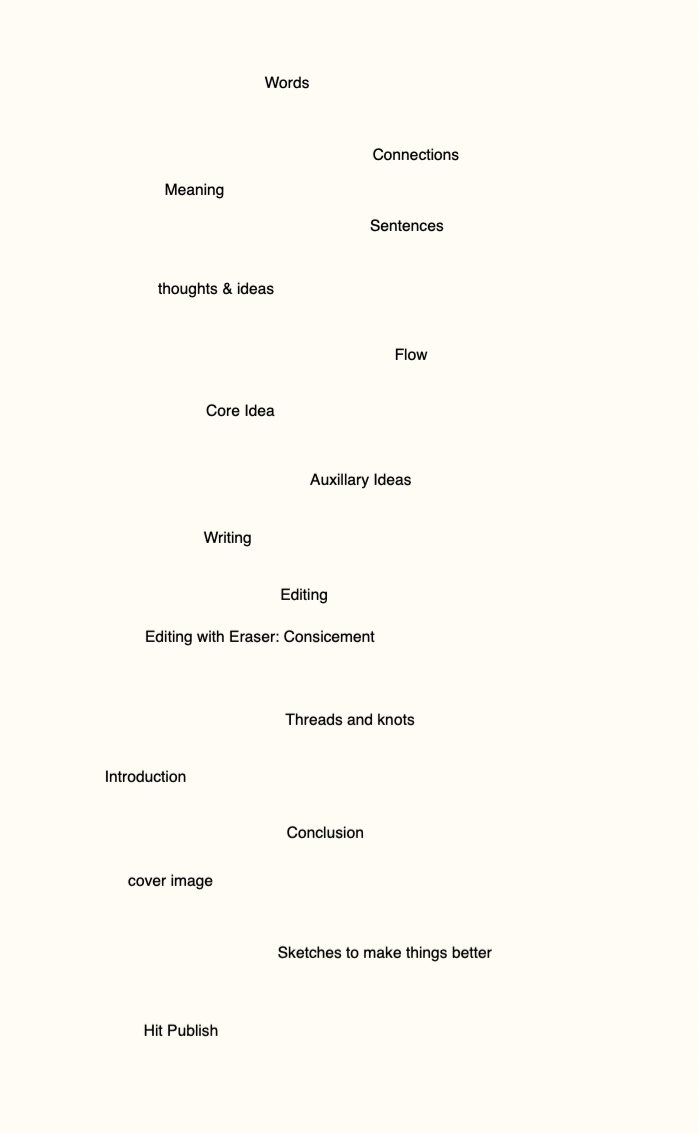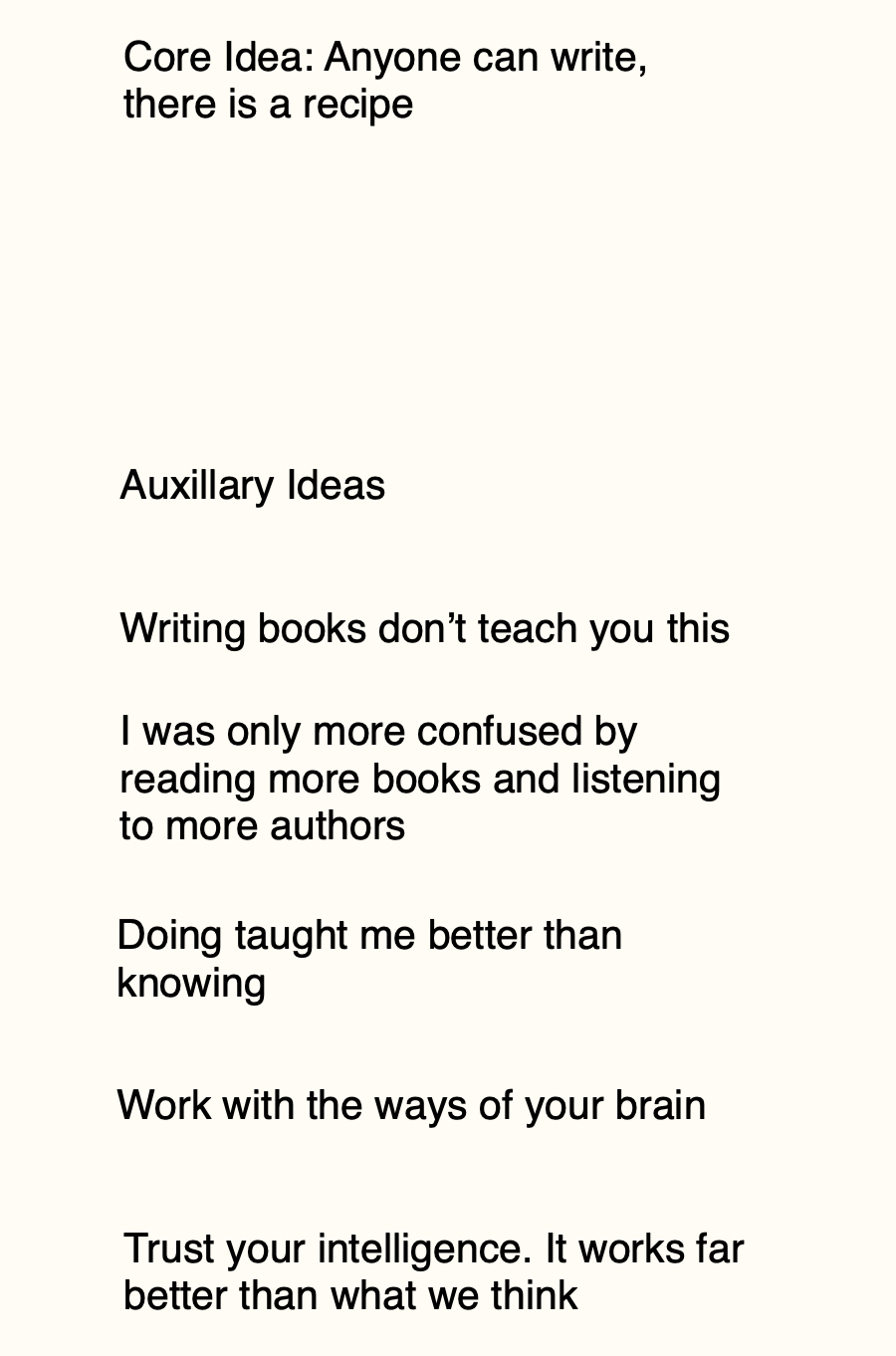How to write anything

A step-by-step guide to write.
It is a mini workshop as a blog. Just do it as you read it. Don't overthink it.One of my friend asked me this question and I am sharing the response to all of you.
Step 1
Answer this question: What do you want to write about?
By now, a few words would pop in your head. Just put it down in a plain sheet of paper like this. If you use tools like scapple app just put down all words out there.
Let me use this article to demonstrate what I follow as a process.

Step 2
Answer this question: do the words make any sense? is there anything I want to share as a central idea?

By now, some ideas will pop in your brain as you have put down the words.
Pick one idea that resonates with you and call it as your core idea. It is typically tweet sized.
Example
My idea for this article: You don't need to be a writer to write anything. You just need to write. Just follow along and at the end of 10 steps you will have a piece to hit publish.
Step 3
What are the auxiliary ideas I can use to tell the story?
Some lines to think: A personal story or anecdote, a concept, a connection, something that you read somewhere, what works and what doesn't? Call out the BS?

Step 4
Connect the core ideas and the auxiliary ideas that makes sense.
Here is my attempt to do that
Believe me writing is far easier than what we are made to believe. If you understand how your brain works, you can feed it the right way.
As a neuro-nerd let me share this with you. All your brain needs is cues and sparks to connect the larger ideas and concepts. Show the cues via your eyes and your brain will start processing. We see 90% with our brains and only 10% with our eyes. Now your brain will connect the dots much faster than you think.
Anyone who has a brain can write in my opinion. Our brains are far superior processing machines than what we think. So if you need to write something here are some phenomenon (laws/truths/core/whatever) to keep in mind
- Writing is thinking. It is a process. It is fuzzy and messy. It is all about big rocks. We don't bother with gravel and sand here. It is disjointed to a large extent.
- Editing is crafting. It is detail oriented. It is all about joining things and making it perfect (to the extent it is worth it). We care about gravel and sand here. We try to fit them in between the big rocks.
- Simple sentences will do. Simple words are easy to comprehend than complex words. Assimilation is better. So don't complicate it.
Here is a 10 step recipe
- Put down the words that pop in your brain, when you think about the topic. The topic is the prompt and when your brain sees it, it searches all the semantic pathways out there and figure out some connections and presents it to you like a search result.
- Now connect the words that spark some thoughts.
- A thought with a form and shape is an idea. So pick out the core idea. This is the thread that runs throughout the piece.
- Use as many auxiliary ideas as needed. I try to keep it to 3 so that it is easier to manage. These are the knots that connects the main thread.
- Sequence it with logic and test the flow. It has to be only one idea explained using more examples and context. Cut everything else ruthlessly.
- Add an introduction that excites the user to read more.
- Add a conclusion that excites the user to take action.
- Add sketches and images to articulate the message even further.
- Arrange the images in a way it makes sense. A visual complements the verbal in ways you can't imagine.
- Hit Publish. Don't think too much.
Step 5
Edit the first draft to makes more sense
In this workblog (my newly invented word for a workshop in a blog) we will learn how to write anything using a recipe. As a system designer it is my job to look for meta frameworks that aids the human brain to think deeper and better. That is all I do day-in and day-out. On those lines, here is a simple framework that can help you write anything.
Let us start with a few (controversial) learnings based on my experience of writing non-fiction for 1000+ days everyday
- How to write books and courses don't teach you how to write the way our brain works (personal experience). For example, a popular advice (even I have said it), put out your core idea as a tweet is the biggest BS I have ever heard because making an idea into 280 characters needs phenomenal simplification and clarity. This is the hardest job out there. This can't be the first step. No wonder we are demotivated to write.
- Like all rabbit holes out there, writing is also a rabbit hole and has its own nuances. You must know some core concepts before venturing into writing. Let me put that down in three pithy sentences here.
- Writing is thinking. It is a process. It is messy and it is disjointed.
- Editing is crafting. It is detail oriented. It is all about joining things and making it perfect (to the extent it is worth it)
- Simple sentences will do. Simple words are easy to comprehend than complex words.
3. Believe me writing is far easier than what we are made to believe. If you understand how your brain works, you can feed it the right way. All your brain needs is cues and sparks. This will help it to connect the larger ideas and concepts. Show it to your eyes (by writing the words down in a paper or screen) and your brain will start processing and connecting the dots much faster than you think. Anyone who has a brain can write in my opinion. Our brains are far superior processing machines than what we think.
So here is the recipe
- Put down the words that pop when you think about the topic. The topic is the prompt and when your brain sees it, it searches all the semantic pathways out there and figure out some connections and presents it to you like a search result.
- Now connect the words that forms the ideas. Discard words that don't make sense in this context.
- Pick out the core idea. This is the thread that runs throughout the piece. There must be only one core idea. More will make your writing messy.
- Use as many auxiliary ideas as needed to make the core idea standout. I try to keep it to 3. It is easier to manage that way. These are the knots that connects the thread (core idea). More like weaving in.
- Sequence it logically. Test the flow. It has to be one idea explained using examples, anecdotes and stories. Cut everything else ruthlessly.
- Add an introduction that excites the user to read more.
- Add a conclusion, that excites the user to act further and take action.
- Add sketches and images to articulate the message even further.
- Arrange the images in a way it makes sense. A visual complements the verbal in ways you can't imagine.
- Hit Publish. Don't think too much.
Now start writing about something you want to share. Go on till step 4 and stop. Your writing ends here.
Editing starts from Step 5 onwards. Do this another time. One sitting is not advised usually. Go and have a coffee. Take a walk or a shower. Do something that is not writing. Come back to the piece later and put on your crafty mode. Edit your piece with an eraser. Cut it, cut it, cut it to a point it cannot be cut anymore. Now polish it with better words, simpler words and shorter sentences.
Add your visuals now. Another post on that sooner.
Go make it happen. Hit publish and tag me when you put out a piece. I'll celebrate with you, my friend.
My Reflection: I could make this piece even better. I could add more images and nuances. Will do later. My writing timer of 45 mins is up and hence i am hitting publish today. We can pick this up later.
Writing never ends. We can always pick an old piece and write it newly. That is the beauty.
🥂 to writing!
